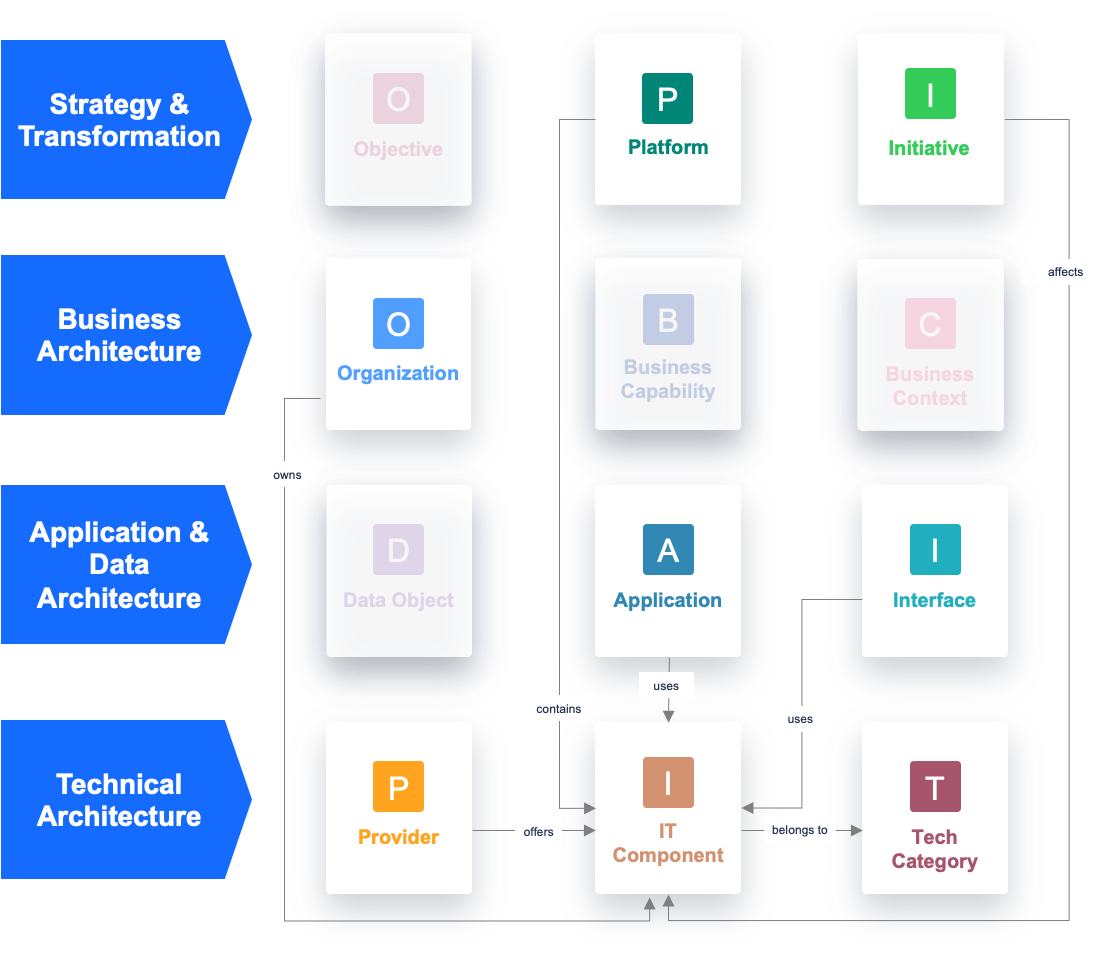LeanIX Technology Risk and Compliance
Proactively manage obsolescence risk and technology standards with Technology Risk and Compliance. Gain transparency of your technology layer, assess interdependencies, and ensure operational stability.
Overview
Technology Risk and Compliance discovers the infrastructure layer of your application landscape, including self-built software and IT components supporting your applications. With additional obsolescence risk views and the ability to visualize a tech radar, you are equipped with the right tooling to gain comprehensive visibility into the tech stack. It allows you to proactively manage tech risk and optimize technology usage throughout your organization.
The Technology Risk and Compliance supports two primary use cases: proactive management of obsolescence risk arising from outdated and unsupported technologies and technology standards management involving strategic optimization of technology infrastructure.
Use Cases of Technology Risk and Compliance
Obsolescence Risk Management:
Obsolete technology no longer maintained or supported carries the risk of breaches, increased downtimes, and system crashes. These issues can result in financial losses, damage to reputation, and regulatory consequences. Obsolescence risk management is the process of identifying, evaluating, and mitigating the risks associated with technological obsolescence.
Technology Risk and Compliance enables you to proactively identify, assess, and manage risks associated with your technology infrastructure. Integration with ServiceNow and custom integration with other CMDBs enables you to automatically discover IT components and build a thorough technology layer inventory. Furthermore, Technology Risk and Compliance offers access to the lifecycle catalog. It provides insights into lifecycle states, version details, and support information needed to continuously monitor the risk of obsolescence.
The LeanIX meta model relationships between IT components and business layer artifacts facilitate the assessment of unaddressed risks and their business impact. Through insightful reports, you can identify, analyze, and prioritize obsolescence risks, focusing on 'end-of-life' concerns and business criticality. Additionally, a dedicated dashboard offers transparency and insights for effective monitoring and measuring progress. With a holistic overview of obsolescence risk exposure, you can allocate resources efficiently to plan and address the risks effectively and ensure operational stability and business continuity.
For a detailed guide on how you can manage obsolescence risk, see Obsolescence Risk Management.

IT Component Fact Sheet Relations - Aggregate Risks From Technology Layer to Applications and Business Layer.
Technology Standards Management:
Technology standards management involves establishing and enforcing standardized practices across an organization's technology infrastructure to ensure strategic alignment and optimization of an organization's technology stack.
Technology Risk and Compliance helps manage technology standards for self-built software and strategically optimize an organization's technology stack to prevent technical sprawl, complexities, and inefficiencies. By effectively managing technology standards, organizations ensure their technology stack remains relevant, containing only necessary, efficient, and beneficial technologies.
A detailed guide on technology standards management use case will be published here soon.
Key Capabilities of Technology Risk and Compliance
| Capabilities for Obsolescence Risk Management | |
|---|---|
| Integration with ServiceNow: | This integration automates the discovery of IT components and applications and helps you build your technology inventory swiftly. Real-time mapping ensures up-to-date information of underlying technology, providing enhanced risk visibility. |
| Access to lifecycle-related information in the catalog: | Enables users to retrieve lifecycle and end-of-support information for IT component fact sheets. Fact sheets are automatically enriched with these data along with information for many other attributes. Ensures organizations can stay informed about the status of their assets and make proactive decisions regarding upgrades, transformations, or replacements, making end-of-life asset management easier. |
| Additional obsolescence risk management views in reports: | Mitigated risk: Helps organizations to assess how effectively they've addressed and reduced risks. Missing data: Helps identify gaps in available information critical for risk evaluation, enabling focused data completion efforts. Unaddressed risk percentages: Helps prioritize and tackle risks that still require attention. |
| Dedicated obsolescence risk management dashboard: | Provides a centralized overview with relevant KPIs for monitoring the progress of your risk management initiatives. Share the progress and insights with stakeholders to provide transparency and foster deeper engagement. |
Related Resources
- For a detailed guide on ServiceNow integration in our documentation, see ServiceNow Integration.
- For a detailed and interactive tutorial on ServiceNow integration in our academy, see ServiceNow Integration.
- For a detailed guide on the lifecycle catalog, see Lifecycle Catalog.
- To learn about obsolescence risk views, see Technology Obsolescence Risk Views in Reports.
- To learn how to monitor risk management initiatives with the obsolescence risk management dashboard, see Obsolescence Risk Management Dashboard.
- To learn how to use the tech radar report, see Radar Report.
- See an example tutorial on analyzing location impact on risk mitigation and compliance: Managing IT Risks Associated with Data Center and Server Locations.
- For detailed instructions and insights into effectively managing technology obsolescence risks, see Obsolescence Risk Management.
Updated 2 days ago
